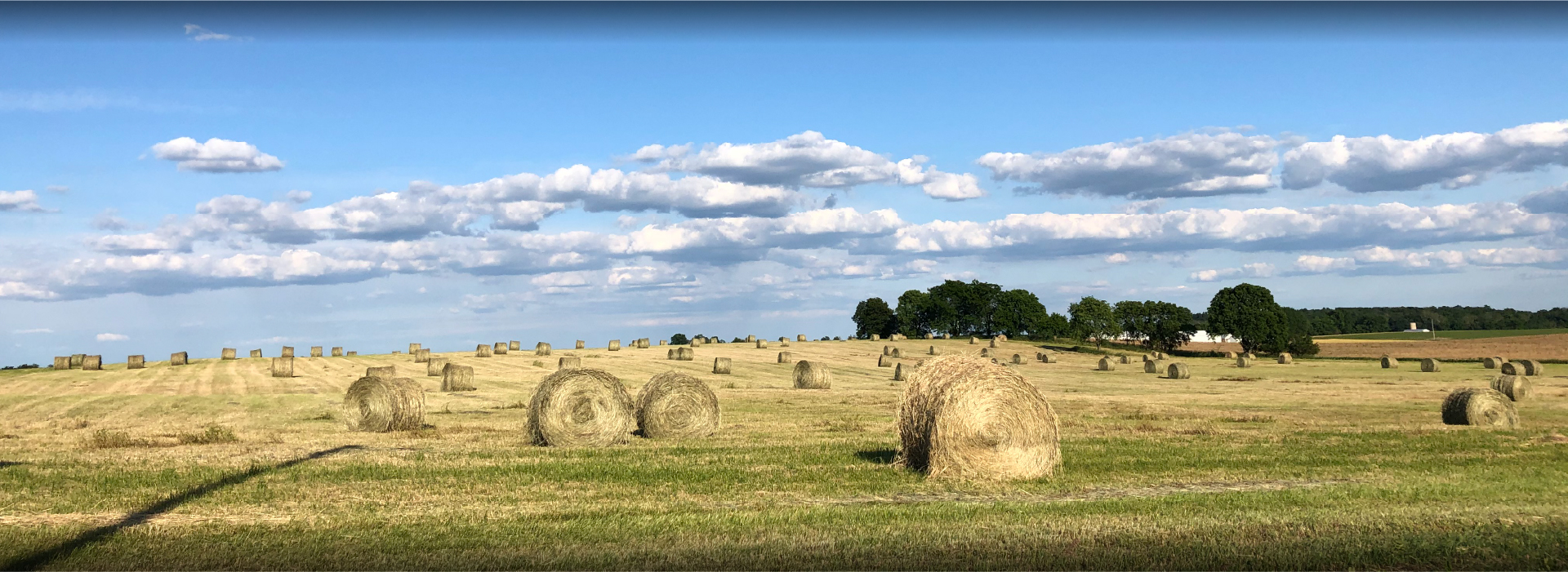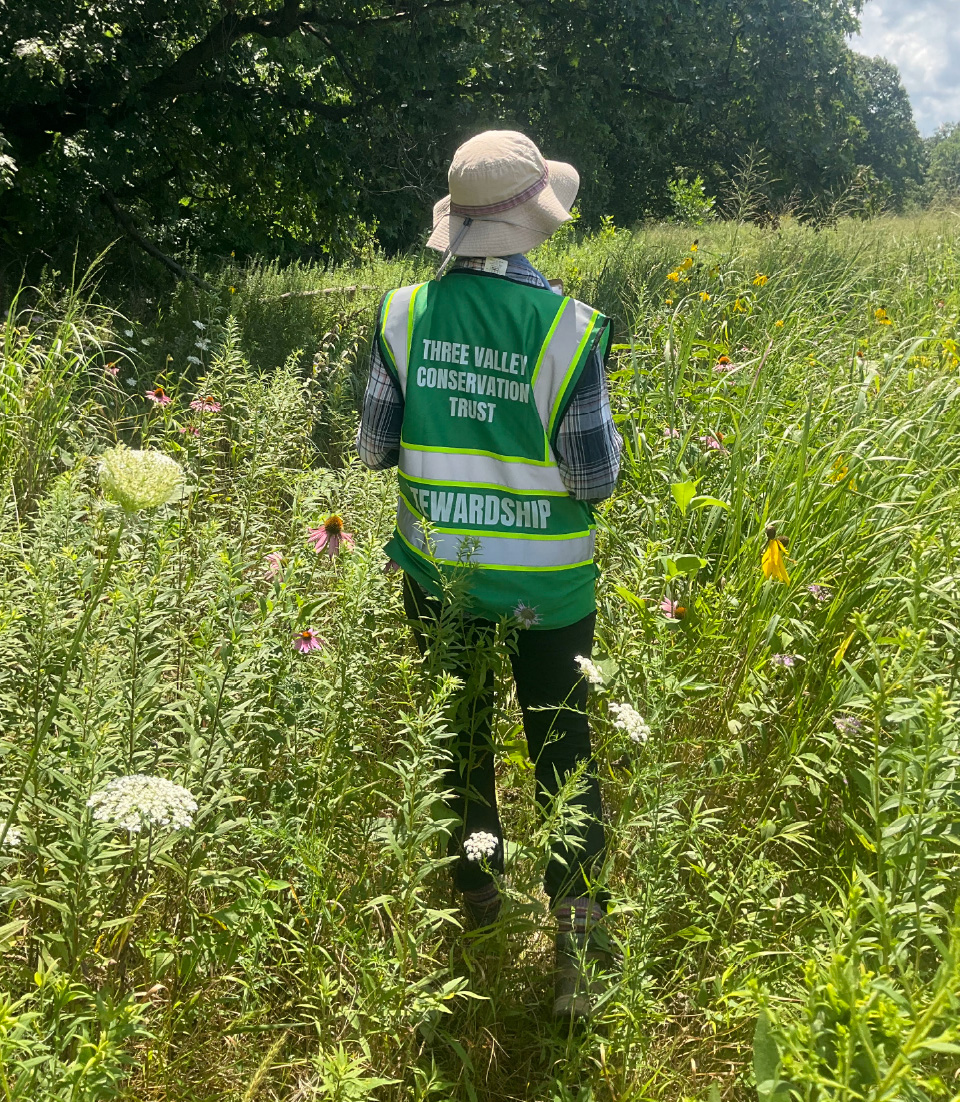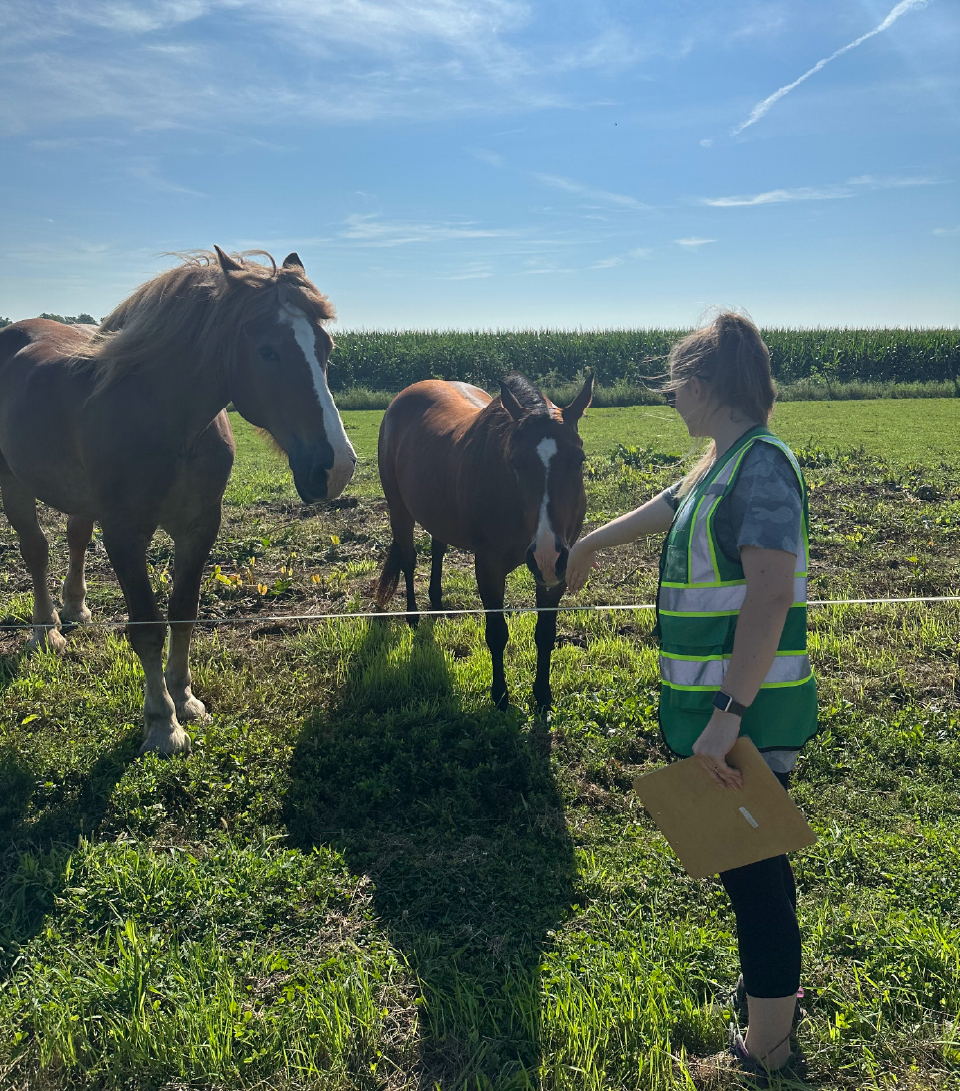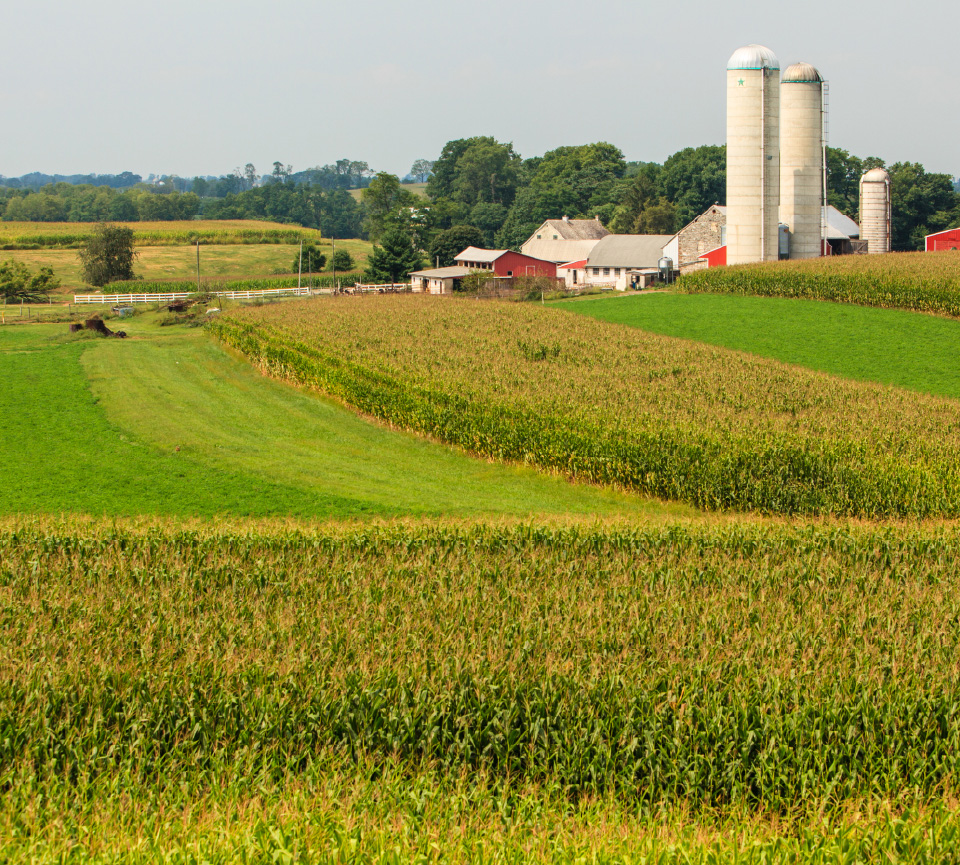

Our goal in effective stewardship is to ensure that the terms of the easement are carried out in perpetuity, protecting the values of the landowner and the property they desire to protect. We strive to maintain positive relationships and effective communication with our landowners as it is an important component for ensuring the terms of the easement and maintaining a successful partnership in conservation.
As the grantee interest in our easements, we hold the legal responsibility to monitor each of our easement properties on an annual basis to ensure that the conservation values are being m aintained according to the terms of the easement agreement. Monitoring inspections allow us the opportunity to document any property condition/land use changes and gives us the opportunity to engage with landowners. We monitor properties on foot and by using a drone. We typically alternate these methods, so one year a property is walked, the next year a property is monitored from the drone. This allows the stewardship team to be efficient with their time, but it also allows landowners an alternating on the ground view as well as a bird's eye view of their land.TVCT staff will contact you prior to each property visit. During this time we request that you keep us informed of any new or upcoming changes being made to your property as well as any concerns that you might have. Notifying our team in advance will be beneficial to both parties in avoiding potential future issues and will help us stay on track to meet our legal obligations.
If you have any questions regarding your easement at any time, such as whether a planned activity is permitted under the terms of your easement, or if an activity requires any notice or approval from TVCT, please contact Three Valley’s Stewardship Team via the contact form below.
Furthermore, we encourage you to seek the input or advice of TVCT staff for land management issues or enhancements on your easement property.


We recognize that property maintenance is labor intensive and often challenging, particularly with increasing encroachment of honey suckle and other noxious invasives in our region. Whether it be managing invasive species or you are interested in implementing habitat restoration practices, there may be state or federal funding available to assist you.
The Ohio Division of Forestry and the Natural Resources Conservation Service (NRCS) work together to provide cost-share opportunities for landowners to conduct management activities on their properties. Activities such as invasive plant control, crop tree release, tree planting, wildlife habitat development and many more can be completed with both technical and financial assistance through the Environmental Quality Incentives Program (EQIP) and the Conservation Stewardship Program (CSP).
Both of these programs are run through NRCS with technical assistance from your local state service forester.
If interested, please see the eligibility requirements, application process and general information located on the Ohio NRCS website link buttons below.
Since 1994, Three Valley Conservation Trust has been recognized by farmers, landowners, and public officials in Southwest Ohio as an important resource for land protection, conservation planning, and environmentally-responsible development.
A conservation or agricultural easement is a voluntary legal agreement between you and a qualified organization − such as Three Valley Conservation Trust − that protects your land while you continue to own it, and beyond. The organization’s duty is to uphold the terms of the easement in perpetuity.
A conservation or agricultural easement (referred to below as a “conservation easement”) is a customized legal agreement that permanently limits certain uses of the land, or a portion of the land, in order to protect its natural and/or agricultural values. An agricultural easement is similar to a conservation easement, but the easement language is altered to limit the land to predominately agricultural activity. The landowner retains all other rights and may sell or transfer the land to heirs, but all future owners are bound by the easement’s terms. Read more about the different types of easements and easement restrictions below.
A Conservation Easement is considered a qualifying charitable donation by the US Internal Revenue Service. Thus, the landowner may be eligible for a federal income tax deduction equal to the appraised valuation of the easement donation – the difference between the land’s fair market value with and without the easement in place. In addition, estate taxes could be reduced, making it easier for heirs to keep the property intact.
Landowners placing their land under easement sometimes receive funding from certain federal and/or state funded, competitive programs. Each program is different, depending on the type and use of the land the program conserves, and each follows a unique methodology and timeline.
The LAEPP program allows local landowners to voluntarily sell property development rights via agricultural an easement to the State of Ohio. The easement limits the use of land to predominately agricultural activity. The land remains under private ownership and management, and stays on tax rolls under Current Agricultural Use Value (CAUV). The farmland can be sold or passed along as a gift to others at any time, but restrictions prohibiting non-agricultural development stay with the land in perpetuity. The LAEPP program contributes up to 75 percent of the fair market value of the agricultural land easement, with a max of $2,000 per acre.
Qualifying farms must be:
We are the local sponsor for Butler and Preble Counties through the Local Agricultural Easement Purchase Program (LAEPP). Funding rounds typically run from January through April each year.
Sample ODA Easement Deed Language
(filed with your county auditor) - This is beneficial to non-applicants as well
NRCS provides financial assistance to eligible partners for purchasing Agricultural Land Easements that protect the agricultural use and conservation values of eligible land. In the case of working farms, the program helps farmers and ranchers keep their land in agriculture. The program also protects grazing uses and related conservation values by conserving grassland, including rangeland, pastureland and shrubland. Under the Agricultural Land component, NRCS may contribute up to 50 percent of the fair market value of the agricultural land easement. NRCS’s ACEP-ALE funding round is usually held in December, though the timing can change from year to year, and additional rounds may be offered if funds remain.
*Subject to legislative change
The Clean Ohio Greenspace Conservation Program provides grants to preserve open spaces, sensitive ecological areas, and stream corridors. The program is funded by the OPWC and helps local communities and conservation partners permanently protect high-quality natural areas. Projects often include the acquisition of forests, wetlands, and other sensitive habitats, as well as restoration activities that improve water quality and enhance wildlife habitat.
The program will fund up to 75 percent of project costs, with applicants providing at least a 25 percent local match. Matching funds can include cash, in-kind services, or the value of donated land. Projects funded under Clean Ohio must be permanently protected with deed restrictions to ensure long-term conservation and prohibit incompatible development. Public access is generally required, whether through trails, parks, or designated natural areas, although the type of access depends on the project’s conservation purpose.
Funding rounds are held annually, typically in late summer or early fall depending on the schedule set by the local Natural Resources Assistance Council (NRAC). Projects are reviewed and ranked by the NRAC before final funding decisions are made by OPWC.
Interested landowners should first contact us to see if their property would be a good candidate for a conservation easement.
Landowners can reach our land protection staff by calling 513-524-2150 ( Ext. 2) or emailing director@3vct.org.
Once we have determined a conservation easement is right for your property, we will have you fill out our intent to apply form, so we can learn more about your property and its history.
We will identify if your property is eligible for any state or federal funding programs or if a donated easement is a better fit for your needs.
If you would like to protect your property with a funded easement, we will identify which program is best for your needs. TVCT will prepare your application and work with you to obtain necessary application documents. The application to closing timeline depends on the funding program and can take up to 1 or 2 years. However, Three Valley strives to have a property closed within a year of the easement funding award notification. All closing costs associated with the easement process will come directly out of the funding award prior to the easement closing. The landowner typically does not have any upfront costs, unless a survey or appraisal is required. For a funded easement, a stewardship donation of 7% of the easement purchase price is requested. The stewardship donation ensures that we are able to legally protect and steward your property in perpetuity.


If you would like to protect your property with a donated easement, you may qualify for a significant tax deduction (more tax benefits details below). Our staff must request and receive board approval to begin your easement process. The first step is a ninety-year title search we will initiate with our title agent. Once a clean title is produced, a property visit is required to create your property Present Condition Report (PCR). Upon completion of the PCR, we will distribute a draft of the easement language for the landowner and attorney to review. When all parties have approved the easement language, the property will be ready to proceed toward closing. For a donated easement, the landowner is required to pay all associated legal and recording fees. As with funded easements, TVCT requests a stewardship donation. This fee is based on a sliding scale that is dependent of the total acreage of the easement.
You can’t sell your land if you have an easement on it.
Land under a conservation easement can be bought, sold, and/or transferred to heirs like any other private property transaction. The landowner never gives up title to their property, therefore, they maintain the rights to sell, lease, and manage their land.
You can’t farm, hunt, fish, or harvest timber on your land under easeme
Land under easement can be actively farmed and most land uses or changes are allowable as long as they maintain or enhance the conservation goals of the easement. Hunting/Fishing is supported within state regulations. Timber harvests coordinated through a state forester are generally allowable.
You have to grant the public access to your land under easement.
Public access is not a requirement for conveying a conservation easement. As with any private property, the landowner chooses who to grant access to their land.
You gain no significant benefits by putting your property in easement.
Conservation easements help to reduce urban sprawl, protect green spaces, provide cleaner air and water, keep prime land available for agriculture & forestry, and protect wildlife habitat. Some properties will qualify for easement funding, which will pay the landowner for their development rights and most landowners qualify for tax deductions for the donation of development rights.
In December of 2015, Congress made permanent a federal tax incentive for conservation easement donations. This could help thousands of landowners like you conserve your land.
Even if you do not qualify or wish not to apply for State or Federal purchase of your easement (a competitive, 1 to 2 year process), you can use this tax incentive to make the perpetual protection of your land a reality.
To learn more, read this informative Land Trust Alliance Brochure about using the Conservation Tax Incentive.
What is this tax credit for?
This tax credit is for landowners who would like to have their land protected from subdivision and development. Landowners who would prefer that their land remain in use as farmland and/or natural habitat. This decision is written into a legal agreement called a Conservation Easement which would be donated to Three Valley Conservation Trust (a 501c3 charitable organization) to be held, monitored and legally defended, in perpetuity (regardless of subsequent owner).
How does the Tax Incentive Work?
The tax incentive works by allowing you to deduct the fair market value of your easement donation, up to 50% of your yearly income (100% if you are a qualified farmer or rancher – see the LTA brochure for more details) for up to 15 consecutive years or until your donation value has been matched by deductions. To qualify for these deductions, the landowner must obtain a property appraisal and IRS Form 8283 from a IRS Certified property appraiser within one year of the easement closing.
Can I donate ownership of my land to take advantage of this tax incentive?
No. This tax incentive was designed for use by owners who wish to retain ownership of their land. That said, as a landowner you are free to sell your land at any time. Please note that Three Valley Conservation Trust is not a qualified tax consulting organization, so landowners should consult their tax advisor to determine total benefits.
Do you still have questions? Want to know more?
More details can be found in the LTA Brochure. If you want to explore option to protect your property, feel free to call 513-524-2150 or email director@3vct.org to get more information.